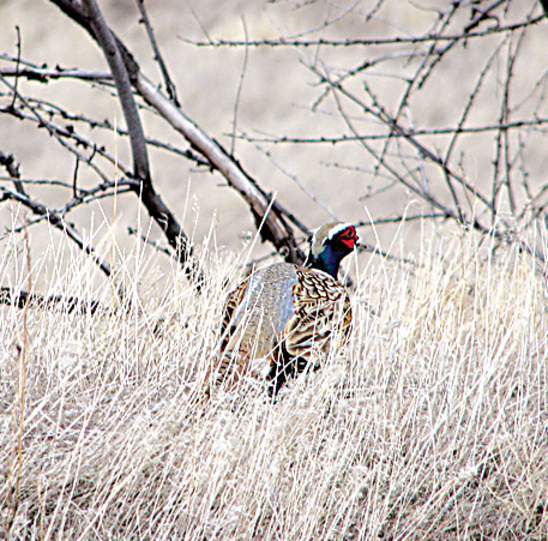Upland bird seasons kick off in September
Published 5:00 am Thursday, August 21, 2008

- Anytime you hunt ground with good cover, you may miss a pheasant or two. Set at least one hunter to act as a blocker at one end of the field.
It begins in the spring. You hear a quail call or hear the chukar cackle from the rimrock and your thoughts turn to the birds you will hunt in September, October, November and beyond.
Early in the year, the hard rains take on a new meaning — welcome in April and May to encourage grasses and wildflowers and insects which feed the young; unwelcome in June when chukar and quail watch over fragile clutches of eggs.
If you’re looking for opportunities to spend more time in your upland bird vest and hunting boots this fall, you’re in luck. The 2008 Oregon Game Bird Regulations are on the shelf and the pages are packed with possibility.
Our dove hunt, which begins Sept. 1, heralds the beginning of bird season. One thing is certain, you couldn’t pick a tougher quarry. To improve your odds, choose a day when the temperature hovers at or above 70 degrees. Most opportunities come to the stander who locates ideal habitat: an old dead tree and still, murky water with a bank free of brush that could hide sharp-toothed predators.
Grouse seasons start at the same time, with a bag limit of three each of blue or ruffed grouse. Water and habitat are the keys to finding “ruffs” in central and eastern Oregon. They are most commonly found in brushy areas of mixed hardwoods, adjacent to swampy lowlands and on the steep hillsides above. Many times, birds can be found feeding on high benches that offer a quick escape downhill. Push the edge of a brushy hillside and be ready to make a snap shot downhill as the bird leaves in a rush of wings.
The sage grouse season runs Sept. 6-14. It is a controlled hunt with a limit of two sage grouse per hunter for the season, which seems like little return in meat for the effort and the fuel expended, but the experience makes up for it. Desert hunters may see pronghorns, wild horses, coyotes and rabbits.
Coming on the heels of last year’s chukar hunt, more than a few of us are looking forward to good news and more time afield this season.
Oregon’s best chukar season in the last 15 years was 2005. An estimated 221,418 birds went home in game bags. A great year as well was 2006, but last year’s harvest was a paltry 41,712 birds. Many hunters stayed home or hunted grouse or quail instead. Early indicators pointed to better conditions in 2008.
Dave Budeau, upland game bird coordinator in Salem, was happy to see the spring rains in April and May. He said that June rains might have destroyed early clutches, but “chukar are persistent re-nesters, and have been observed re-nesting well into July.”
Chukar, Hungarian partridge and quail seasons open Oct. 11. Pheasant season begins Oct. 18.
If you’ve traveled around the state, it’s likely you’ve seen more turkeys than in years past. This year, the General Fall Turkey Season (Curry, Josephine, Jackson, Coos, Douglas, Lane, Benton, Polk, Marion and Linn counties) begins Oct. 15 and runs through the end of the year.
The Controlled Fall Turkey hunt has been expanded to take in a bigger chunk of eastern Oregon. Deer and elk hunters, if they carry the proper permit, can tag a turkey as well. The application deadline is Sept. 15.
The Oregon Department of Fish and Wildlife has unveiled the new Oregon Hunter Access Map, available at www.dfw.state.or.us/resources/hunting/map. The map features state wildlife areas, refuges and private lands open to public hunting. Users can customize maps, check out satellite views, calculate distance and produce driving directions.
A lot of new hunters have already taken to the uplands and the marsh in ODFW’s new Mentored Youth Hunting Program. The MYHP allows youth between the ages of 9 and 13 to hunt while closely supervised by a licensed adult. Only one firearm or bow may be carried between the two hunters. To participate, youth must complete a program registration form. See page 42 of the new regulations.
Fall upland bird seasons are a great way to introduce a youngster to the sport or to take an old-timer back to the field.
To the young, the relationship of spring rains to fall harvest is not quite as apparent as it might be to someone with gray in the hair. But the hunt inspires a lifelong fascination with the land that, whether it comes early or late in life, makes us turn in our waking dreams to the horizon. We calculate the timing of the rains in the spring and, as September draws near, we close our eyes, see the dog working close in heavy cover and hear the cackle of a rooster and the wind that beats beneath its wings.






